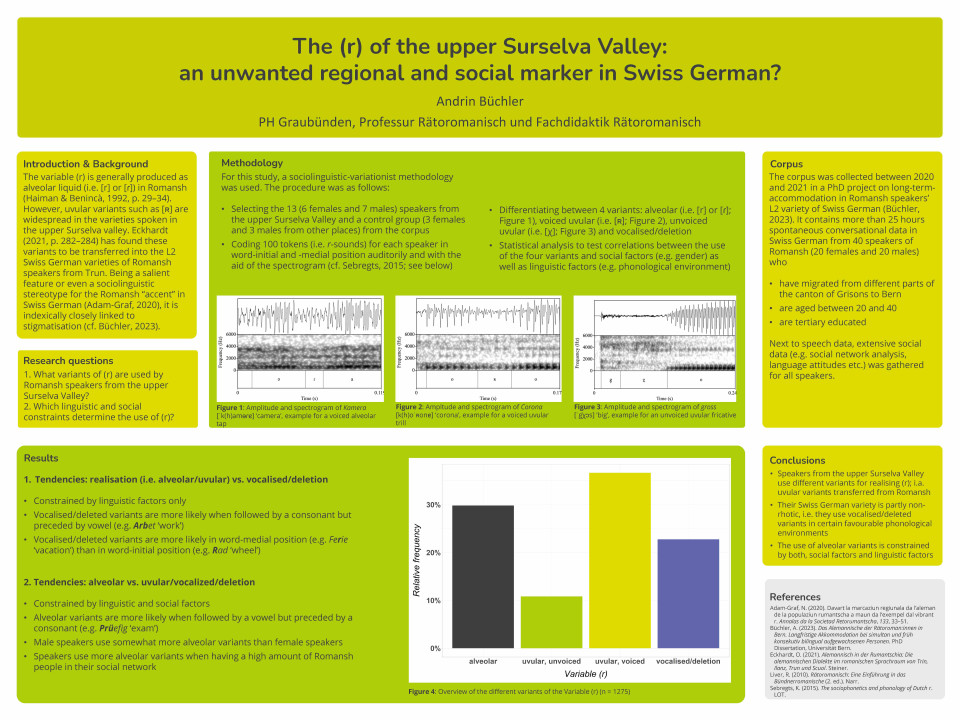To date, only little is known about the phonetics of the variable (r) in Romansh. (r) is generally said to be produced as alveolar liquid (i.e. [r] or [ɾ]) in Romansh (Liver, 2010, S. 132). People however are well aware that uvular variants such as [ʀ] are widespread in the varieties spoken in the upper Surselva Valley. It is thus no surprise that Eckhardt (2021, S. 282–284) has found these variants to be transferred into the L2 Swiss German varieties of Romansh speakers from Trun. Another recent study has looked at the variable from a perspective of perceptual dialectology. Adam-Graf (2020) demonstrates that uvular variants are very salient and even more so function as sociolinguistic stereotype. This means that in the Grison context, people using these variants are quite readily recognised as Romansh speakers and sometimes even stigmatised because of their L2 variety of Swiss German (Büchler, 2023).
The first research question is concerned with what variants of (r) Romansh speakers from the upper Surselva Valley use in Swiss German if they live outside the canton of Grisons, in German-speaking Switzerland. The second research question focuses on variation and asks which linguistic and social constraints determine the use of (r). For this, a sample of 19 speakers was taken from a larger corpus containing spontaneous conversational data in Swiss German by Romansh speakers who have migrated from Grisons to Bern (Büchler, 2023). 13 (6 women and 7 men) grew up in the upper Surselva Valley and six (3 women and 3 men) in other places of the Romansh area thus forming a control group. Variationist sociolinguistic methods were used: The r-sounds in the conversational data were coded auditorily and with the aid of the spectrogram (Leemann et al., 2018; Sebregts, 2015). Four variants were differentiated: alveolar (i.e. [r], [ɾ]) – uvular voiced (i.e. [ʀ], [ʁ]) – uvular unvoiced (i.e. [χ]) – vocalised/deleted. Different social (e.g. gender or place of residence) and linguistic factors (e.g. phonological environment or stress) were tested statistically for correlations to the use of the four variants.
As expected, results show that the place of residence is a key social factor: only the speakers from the upper Surselva Valley used the uvular variants, whilst the speakers from the control group used alveolar variants. Somewhat suprisingly, the former group also showed a pronounced tendency to use vocalised/deleted variants. However, the distribution is highly dependent on linguistic factors: vocalisation/deletion is most prominent after a vowel and before a consonant (e.g. [faːt] for faart ,(he) drives‘). Further linguistic and social factors will be presented and discussed with respect to the sociolinguistic context.
References
Adam-Graf, N. (2020). Davart la marcaziun regiunala da l’aleman de la populaziun rumantscha a maun da l’exempel dal vibrant r. Annalas da la Societad Retorumantscha, 133, 33–51.
Büchler, A. (2023). Das Alemannische der Rätoroman:innen in Bern. Langfristige Akkommodation bei simultan und früh konsekutiv bilingual aufgewachsenen Personen [Nicht publiziert]. Universität Bern.
Eckhardt, O. (2021). Alemannisch in der Rumantschia: Die alemannischen Dialekte im romanischen Sprachraum von Trin, Ilanz, Trun und Scuol. Steiner.
Leemann, A., Schmid, S., Studer-Joho, D., & Kolly, M.-J. (2018). Regional Variation of /r/ in Swiss German Dialects. Proceedings Interspeech 2018, 19th Annual Conference of the International Speech Communication Association, Hyderabad, India, 2018, 2738–2742.
Liver, R. (2010). Rätoromanisch: Eine Einführung in das Bündnerromanische (2. Aufl.). Narr.
Sebregts, K. (2015). The sociophonetics and phonology of Dutch r. LOT.
Quiz question
Wie wird der für das Rätoromanische der oberen Surselva typische r-Laut produziert?
mit der Zungenspitze am Zahndamm (alveolar)
mit den Lippen (bilabial)
mit dem hinteren Teil der Zunge im Rachen (uvular)
